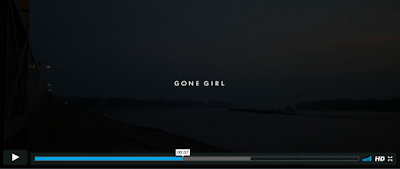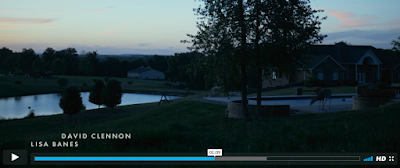Gone Girl (Dir. David Fincher, 2014).
The title sequence of the thriller film 'Gone Girl' starts with a black screen and a incidental, non-diegetic drone. The high key, non-diegetic drone is used to create suspense and to instantly draw the audience's attention. After a second of the screen being pitch black, 'TWENTIETH CENTURY FOX and REGENCY ENTERPRISES present' appears on the screen in white. After a couple of seconds of it being on the screen, it fades back to black. Then, a voice over of a man starts saying 'when I think of my wife, I think of her head' just before the second message flashes up on the screen in white: 'a DAVID FINCHER film'. The use of the juxtaposition colours, black and white, is effective due to the fact that it demonstrates to the audience that there are good and bad characters in 'Gone Girl'. The contrast in the colours black and white are conventionally shown in thriller title sequences to show that someone or something is going to break the equilibrium in the film. This emphasises the tension and suspense of the thriller film.
The second shot in the title sequence of 'Gone Girl' is a medium close up shot of a woman with an expressionless face. This shot is used to show the audience that she is strange as she does not show any facial expressions to the man who is gently stroking her head: just stares. The incidental, non-diegetic drone and the voice over of the man is continued throughout this shot when he says 'I picture cracking her lovely skull, and spooning her brains, trying to get an answer'. This voiceover implies to the audience that the man and woman's marriage is unstable. The lighting in this shot is low key which intensifies the shadows around her and makes the woman in the shot appear quite moody and scary to the audience. The woman in the shot appears to be quiet pale skinned which could imply to the audience that the woman is physically or mentally unwell. The camera then slowly fades to black which suggests to the audience that time has passed.
In this shot of the title sequence in 'Gone Girl', the camera uses a long shot to show the audience the deserted environment. The shot uses low key lighting to create eerie atmosphere which is conventional for thriller films. The incidental, non-diegetic drone is sound bridged into this shot which upholds the suspension and supports conventionalisation of the thriller genre. A diegetic sound of water from the lake appears in the back ground to make the shot seem more realistic. Then the name of the film 'Gone Girl' appears on the screen in white writing, then slowly fades to silver, and finally completely fades away. This use of editing on the title of the film is effective as it reflects what the film is about: a girl who suspiciously disappears.
The pace of editing then increases and jump cuts to four different images of the environment over a period of eight seconds. This is effective as it gives the audience a sense to what the environment is like in this thriller film. In all the four shots, the lighting is low key which emphasises the tension as it makes the scene appear scarier. The sinister environment encourages the audience to keep watching the thriller film as it makes them want to see what's going to happen next. The incidental, non-diegetic drone is once again sound bridged into this shot which maintains the suspension and encourages the audience to continue watching.
The camera then shows an establishing shot of a peaceful environment in a low key lighting which identifies to the audience that it's early in the morning and nobody is awake. The only moving object in the shot is an animal which suggests that the area is deserted and everyone is asleep as the animal is comfortably exploring the environment. The incidental, non-diegetic drone is again sound bridged into this shot which is effective as it suggests that the man speaking in the voice over has been awake for a long time as the shots have been continuous. Diegetic bird sounds are also introduced at the end of this shot which makes the scene appear more realistic to the audience and makes them feel like they are actually a part of the thriller film.
With the incidental, non-diegetic drone continuing throughout the clip, the camera shows nine different images of the environment which look like conventional thriller film settings, such as a new house, a deserted building, and a backstreet, before the camera tilts upwards to show the audience a low angle shot of an old fashioned clock in the middle of the street. The low angle shot of the clock is used to identify the significance of the clock as it confirms that it is early in the morning as it shows to be five to seven in the morning. The old fashioned look of the clock connotes a sinister atmosphere as vintage objects are conventional to thriller films. The clock could also imply to the audience that its not long before the equilibrium is broken which encourages them to keep watching.
The camera then cuts to a medium shot of the man, who was speaking in the voice over, stood expressionlessly on the end of his drive wearing casual clothes. The neutral facial expressions from the man suggests to the audience that he is tired due to his lack of sleep during the night and confused about his marriage. This links back to when the man said that he was 'trying to get an answer' from his wife's brain. This implies to the audience that the couple are having trouble with their marriage and the woman is hiding something from the man. The low-key lighting in the image suggests that the man is unaware and in the dark about hat his wife is hiding from him. The incidental, non-diegetic drone and the diegetic bird sounds are sound bridged into this shot which makes the jump cuts smoother to the audience as the sound is just continuing.
The camera then uses editing to use the match in action technique which shows the man in the same place but from an alternate angle. The man is shown in a long shot to be looking around the environment in confusion. The long shot of the man identifies his vulnerability due to the fact that he is all alone and his marriage is troubled. The man is also centre screen which implies to the audience that his character is significant to the story. This encourages the audience to pay more attention to him. The incidental, non-diegetic drone is still continuing and is conventional for thriller films as it creates a suspension and sinister atmosphere. Diegetic bird sounds are also sound bridged into this shot which implies to the audience that the man has been stood on the end of his drive from a long time as the birds have been tweeting through a number of shots. The duration of the man stood on the end of his drive is sixteen seconds and is broken down into three shots, which were matched in action. This duration of the shots allows the audience to really feel and connect with the man's emotions. This is effective as it allows the audience to understand his character a little and makes them feel like they can relate to how he's feeling. Therefore, this encourages the audience to continue watching.
The camera then shows an extreme long shot of the man walking towards house. After a second of the shot commencing, white writing appears on the screen saying 'July 5th' which implies to the audience that it's a significant piece of information for the story. The camera is at a slight low angle which makes the house appear intimidating. The house looking intimidating could also reflect his feelings to the audience and imply that he doesn't want to go back inside which suggests why he was stood outside for a long period of time. The incidental, non-diegetic drone is again sound bridged into this shot, however is slowly faded out as the screen fades to black. This is effective as it encourages the audience to keep watching to see what will happen next.









No comments:
Post a Comment